Abstract
For push–pull locomotion, it has been confirmed by this research group that the support force of the wheels is enhanced by performing the sinking operation to provide support force. However, the sinking operation is an additional operation used for the rover to travel. Ideally, if the rover can operate without sinking, travel efficiency is improved. On the other hand, flexible wheels are often used for the rover. Due to stress dispersion, these wheels are less likely to damage the ground. Therefore, it would be beneficial if the use of these wheels could improve the travel ability of the push–pull motion. In this study, we focused on whether the use of flexible wheels can avoid subsidence and tested their performance through different parameters.
1. Introduction
To explore the origins of the solar system and investigate the existence of life outside Earth, many institutions are actively exploring the universe.
As exploration tools, rovers are important for space exploration. JAXA launched the Hayabusa rover to the asteroid Itokawa in 2003, and Hayabusa returned to Earth with samples in 2010 [1]. JAXA then launched Hayabusa2, the successor of Hayabusa, to the asteroid Ryugu, and it returned with samples in 2020 [2]. In 2011, NASA launched the Curiosity rover to Mars, and it landed in 2012. As of April 2021, it is still collecting data and moving around [3].
The wheel-type mobile system is easy to control and operate, and it can utilize multiple wheels at the same time to increase traction and mobility. Its comparatively simple structure also provides a low failure rate and lower cost. For this reason, it has been used as the main moving mechanism for planetary exploration rovers. However, when rovers travel on sand, they slip and even become stuck. For example, the Mars rover Spirit came to the end of its mission due to the right front wheel becoming stuck in the sand at a location called “Troy”. Also, the Opportunity Mars rover experienced a serious wheel slip during its mission [4]. A rover has a lower travel efficiency when traveling on loose soil. Unfortunately, in planetary exploration, some scientifically valuable locations require the rover to travel through loose soil. It is necessary to improve the travel ability of the rover on loose soil. In order to suppress slipping and the susceptibility to becoming stuck, many mobile mechanisms have been investigated [5]. As a rover with a high obstacle-crossing capability, the legged rover’s trajectory consists of a series of discrete traces, which allows it to adapt to complex terrain [6]. But complex mechanical design and control algorithms are difficult to maintain. Tracked rovers possess an off-road capability and are less likely to become stuck in loose surfaces. However, they have poor maneuverability, and they are especially difficult to steer; the complexity of the architecture also reduces its reliability [7]. In addition, hybrid motion that combines multiple types of motion has also been proposed. For example, a leg-wheel hybrid robot [8] and a leg-track-wheel robot [9]. However, hybrid motion tends to require more complex control than a single movement, and the wheeled type is more reliable and more energy-efficient than the non-wheeled type [5]. To improve travel on loose slopes while maintaining wheel reliability push–pull locomotion, used in the Scarab (Figure 1) by C. Creager [10], has been confirmed to have high traveling performance.

Figure 1.
Push–pull locomotion.
Push–pull locomotion is a type of locomotion by which the rover moves by extending and retracting the wheelbase using actuators at the joints in addition to wheel driving (Figure 1). Previous studies using the Scarab rover have confirmed that push–pull locomotion can reduce wheel sinkage and improve travel efficiency compared to normal travel [10].
To further improve the ability of a rover utilizing push–pull locomotion to travel on a loose slope, a method of intentionally sinking the wheels that provide support has been proposed [11]. By sinking the wheels, the contact area between the wheels and the ground is increased. This provides the wheels with increased support. Thus, the wheels can provide more traction or support when the wheelbase changes. Therefore, a rover utilizing push–pull locomotion has a better mobility performance [12].
However, it takes time for the rover to sink its wheels, and that time increases with the amount of sinking required. In addition, a cycle requires two sinking movements of the front and rear wheels, and even though each sinking time is short, the sinking time increases as the number of movements increases. This reduces the rover’s traveling speed. Therefore, a solution that can improve push–pull locomotion mobility performance without additional actions is necessary.
C. Creager [10] conducted drawbar pull tests on the Scarab with pneumatic wheels. Results show that the pneumatic wheels provide approximately 37% of the rover’s weight in drawbar pull force. The rigid wheels provide 33% of the rover’s weight in drawbar pull force. Therefore, it has been proven that wheels with flexibility, such as pneumatic tires, have an advantage in push–pull locomotion. As mentioned above, the large sinkage of the locked wheel contributes to suppressing the slip. Meanwhile, the large sinkage could induce becoming stuck. On the other hand, the driving performance of Push-pull locomotion with a flexible wheel could be equivalent to the rover with a rigid wheel that uses additional sinkage. The proof of this hypothesis contributes in eliminating excess sinking action and improving traveling speed. However, the experimental data regarding the comparison between the push–pull locomotion using advanced sinking with a rigid wheel and using a flexible wheel are lacking. Therefore, this study conducts an experimental driving test for push–pull locomotion using flexible wheels at different wheel configurations and clarifies whether the excess sinking action is eliminated or not.
2. Support Force of Flexible Wheels
In rolling mode, the deformation of the flexible wheel increases the ground contact area and the wheel’s trajectory relative to the ground is closer to that of a track, resulting in better travel ability [13]. However, push–pull locomotion is characterized the use of locked wheels to provide a support force for the rover, thus reducing the rover’s slip rate. So, analyzing the forces on locked wheels can predict the effect of flexible wheels on rovers with push–pull locomotion.
Flexible wheels are wheels made of flexible materials that deform under an external force. As the flexible wheel deforms, the contact area between the wheel and the ground increases.
Referring to the support force of the locked wheel as a rigid wheel [10], we can obtain the support force of the locked wheel when it is a flexible wheel.
where is the shear force that shears the ground under the wheel. is the horizontal component of the shear force between wheel surface and soil. is the friction force of the wheel on the surface perpendicular to the soil. As deformation increases the contact area between the elastic wheel and the ground, it increases the shear force on the bottom surface of the wheel.
In this case, the support force that the wheel receives from the soil is shown in Figure 2b.

Figure 2.
(a) Force acting on the flexible wheel; (b) schematic view of the flexible wheel model when the wheel bulldozes soil mass.
In Equation (2), is a constant defined as the wheel width, and can be calculated as follows:
where is the cohesion of the soil and is the angle of the internal friction of the soil. Because of the deformation of the wheel, the contact area of the wheel with the soil increases, the shear length of the soil also increases, and with a fixed wheel width, the shear area of the soil increases while dragging the wheel. This causes the shear force to increase. The support force obtained from the soil mound is affected by the sinkage . When the sinkage is the same, the change in is not significant. As a result, the support force of the wheel is increased.
3. Single-Wheel Test
When a rover slides, the locked wheels slide and sink at the same time. As the wheel sinks, the support force changes. By observing the relationship between sinking and resistance, we can confirm the ability of the locking wheel to provide support. In this section, the forces on the locked wheels in push–pull locomotion are verified by a single-wheel test.
3.1. Single-Wheel Test Environment
The environment for the single-wheel test is shown in Figure 3, and the parameters are shown in Table 1. The wheels used in the experiment are shown in Figure 4. For comparison, a rigid wheel with the same parameters as the elastic wheel was prepared as a control. The flexible wheels are made of stainless steel (sus304), and the parameters are shown in Table 2. The experimental setup consists of guide rail, worm gears, sandboxes, and stepper motors. The measurement equipment consists of a force sensor and a motion capture system. The motion capture marker was set at the position shown in Figure 5. To have the same load as when mounted on the rover, a load of 4.9 N was attached to the wheels.
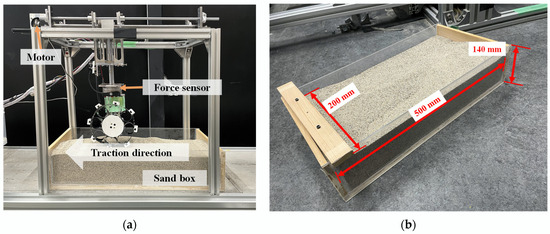
Figure 3.
(a) Single-wheel testing machine and surrounding environment; (b) single-wheel testing field.

Table 1.
Setting of the single-wheel experiment.
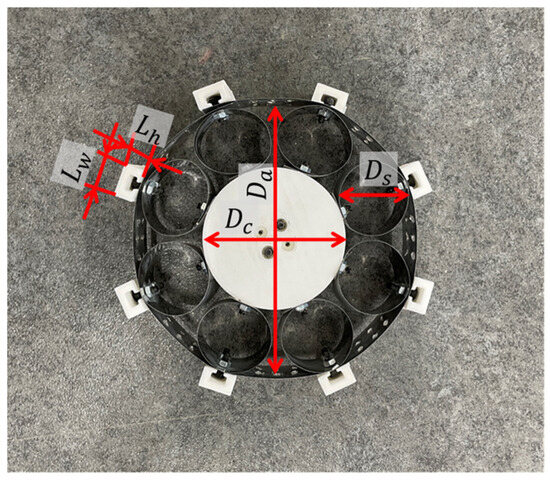
Figure 4.
Flexible wheel.

Table 2.
Details of the flexible wheel.
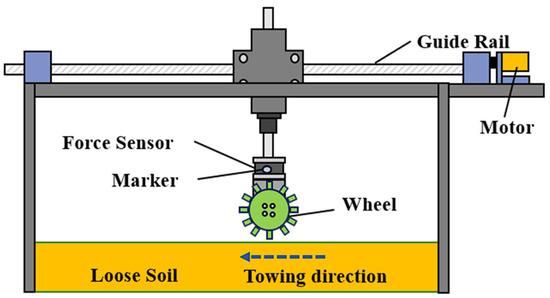
Figure 5.
Schematic diagram of the single-wheel testing machine.
3.2. Results of Single-Wheel Test
Figure 6, Figure 7, Figure 8 and Figure 9 show the experimental results. Figure 6, Figure 7 and Figure 8a shows that the number of lugs has a more pronounced effect on the flexible wheel’s performance. However, as shown in Figure 6, Figure 7 and Figure 8b, the effect of lug change on the rigid wheel is less than that of the flexible wheel, but during the latter part of the experiment, the increase in the support force of the rigid wheel is lower than that of the flexible wheel.
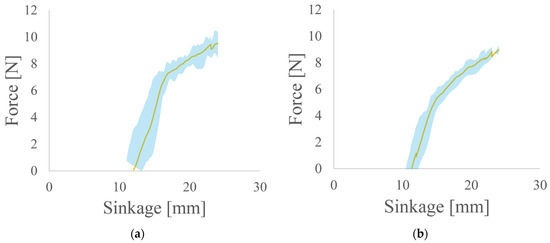
Figure 6.
(a) Flexible wheel with eight 7 mm-wide lugs; (b) rigid wheel with eight 7 mm-wide lugs. The blue area indicates the range between the maximum and minimum values in the data.
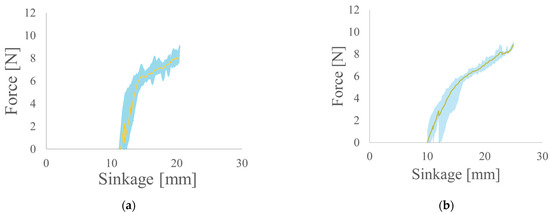
Figure 7.
(a) Flexible wheel with sixteen 7 mm-wide lugs; (b) rigid wheel with sixteen 7 mm-wide lugs. The blue area indicates the range between the maximum and minimum values in the data.
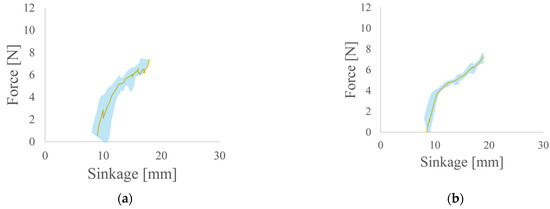
Figure 8.
(a) Flexible wheel with twenty-four 7 mm-wide lugs; (b) rigid wheel with twenty-four 7 mm-wide lugs. The blue area indicates the range between the maximum and minimum values in the data.
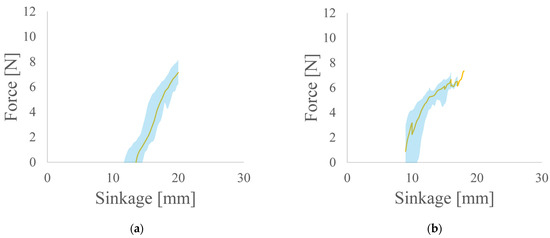
Figure 9.
(a) Flexible wheel with eight 14 mm-wide lugs; (b) rigid wheel with eight 14 mm-wide lugs. The blue area indicates the range between the maximum and minimum values in the data.
With twenty-four 7 mm-wide lugs fitted (Figure 8), both wheels have a similar support force. This can be hypothesized as the number of lugs is too large to sink completely, which has an effect on the wheel sinkage. Also, the lugs are too many for the wheel and have an effect on the deformation of the wheel.
Comparing Figure 6 and Figure 9 for the same sinkage, the support force becomes larger as the lug width increases.
Since the amount of sinkage of the flexible wheel is less than that of the rigid wheel by the end of the tow, we selected the maximum sinking of the flexible wheel of 20 mm as reference data. To compare the increasing ratio of the resistance force, this paper calculates the slope of each graph (Figure 6, Figure 7, Figure 8 and Figure 9) as follows:
where is the force exerted on the wheel at a sinkage of 20 mm, is the sinkage, and is the initial sinkage. The results are shown in Table 3. In this scenario, most of the flexible wheels exhibit a greater force than the rigid wheels. However, in the case of 8 lugs with eight 14 mm-wide lugs, the force of the flexible wheel is slightly lower than that of the rigid wheel. Nevertheless, the rate of force increase for the flexible wheel in this situation is significantly higher than that of the rigid wheel. It can be predicted that continued traction would result in the flexible wheel achieving a higher force than the rigid wheel. Therefore, it can be concluded that flexible wheels can achieve better mechanical performance than locked wheels. The results confirm that the use of flexible wheels could help eliminate sinking in push–pull locomotion.

Table 3.
Wheel force and force growth rate with respect to 20 mm sinkage.
4. Drivability Experiments
This experiment compares the slip rate of a rover with flexible, rigid wheels for both push–pull locomotion and push–pull locomotion with sink while climbing a slope.
4.1. Drivability Experiments Environment
The testbed used for the experiment is shown in Figure 10a. The specifications of the testbed are shown in Table 4. The experimental setup consists of a sandbox and a motion capture system (Figure 10b). The experimental setting is shown in Table 5. The experimental field was a 500 mm-wide, 2350 mm-long, 300 mm-deep sandbox filled with silica sand No. 5 to a depth of 110 mm. The motion capture marker was set on the torso in front of the rover. The push–pull locomotion with subsidence motions were as follows:
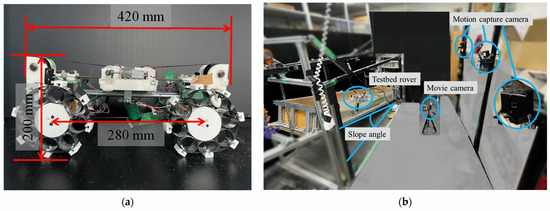
Figure 10.
(a) Testbed rover; (b) experimental settings for the climbing experiment.

Table 4.
Testbed rover parameters and values.

Table 5.
Experiment settings for the climbing experiment.
- Front wheel spinning and sinking.
- The rear wheel rotates when the front wheel is locked while the wheelbase decreases and the rear wheel pulls up.
- Rear wheel spinning and sinking.
- The front wheel rotates when the rear wheel is locked while the wheelbase expands and the front wheel pushes up.
The rover with both types of wheels used travelled both with and without the sinking effect applied.
4.2. Results of the Drivability Experiments
The experimental results are shown in Figure 11, Figure 12, Figure 13 and Figure 14, where w/sink and w/o sink indicate whether the supporting wheels use the sinking effect or not. Figure 11, Figure 12 and Figure 13 show the travel distances of the rover when the width of the lug is fixed at 7 mm and the number of lugs is changed. When the number of lugs is fixed to eight, the mobility performance of the rover with flexible wheels is lower than that with rigid wheels, and the mobility performance of the push–pull locomotion with sink is higher than that of push–pull locomotion without sink. This is caused by the fact that the lug intervals are too long, and there are fewer lugs inserted into the soil, which results in less support. However, with the number of lugs fixed to 24, the high number of lugs results in less support due to the lugs not being able to be fully inserted into the soil.
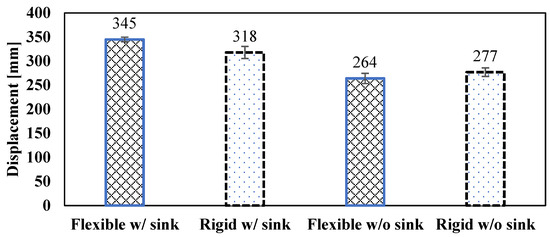
Figure 11.
Displacement of the rover; lug parameters (number, 8; width, 7 mm).
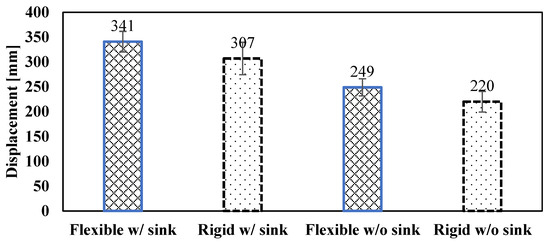
Figure 12.
Displacement of the rover; lug parameters (number, 16; width, 7 mm).
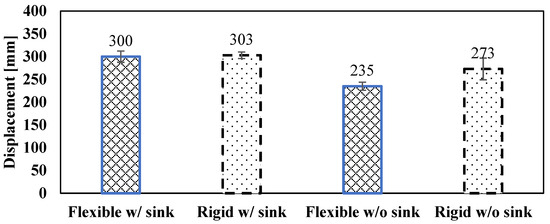
Figure 13.
Displacement of the rover; lug parameters (number, 24; width, 7 mm).

Figure 14.
Displacement of the rover; lug parameters (number, 8; width, 14 mm).
Figure 11 and Figure 14 show the travel distance of the rover when the number of lugs is fixed at eight and the lug width is changed. The results in Figure 11 show that with a wheel width of 7 mm, when the sinking action is used, the travel distance is longer when equipped with flexible wheels than when equipped with rigid wheels. However, when the sinking action is not used, the travel distance is similar. Figure 14 shows the travel distance of the rover when the lug width is 14 mm. Under this parameter, the mobility generated by the push–pull locomotion without sinking when equipped with flexible wheels is the same as that with sinking when equipped with rigid wheels. Overall, the travel distance was enhanced when the rover was equipped with flexible wheels. This is consistent with the results of the single-wheel experiment, where flexible wheels tended to have greater support.
These results suggest that a flexible wheel that can be inserted with more lugs may have the same mobility as a rigid wheel that uses wheel sinking by suppressing slip when the wheel is supported.
5. Conclusions
This paper investigated a more effective configuration of push–pull locomotion. Specifically, this paper focused on the effect of the flexible wheel and confirmed its traveling performance through the single-wheel experiment and driving experiment on loose soil. Then, the experiment confirmed whether the push–pull locomotion with flexible wheels has an equivalent performance to push–pull locomotion with rigid wheels using large sinkage or no sinkage. The support forces provided by the flexible wheel and the rigid wheel at rest were compared through a single-wheel experiment. In addition, the influence of parameter changes on the flexible wheel was observed by changing the number and width of the lugs on the fixed wheel. Then, we conducted a driving experiment. The driving experiment on loose soil with slopes confirmed the rover’s traveling performance under conditions of sinking and without sinking.
The contributions of this paper are as follows:
- As lockable wheels, flexible wheels provide higher support.
- With certain parameters, the use of flexible wheels can replace the sinking action during push–pull locomotion.
- The impact of other parameters of the flexible wheels on driving performance remains to be verified.
These results demonstrate that the use of flexible wheels that do not sink can achieve the same travel ability as the use of rigid wheels and sinking wheels in Push–pull locomotion. Omitting the sinking process can increase the travel speed of the rover. Therefore, in push–pull locomotion, flexible wheels can increase the travel speed of the rover. In the future, we will investigate the factors affecting the support force when flexible wheels are used as locking wheels in push–pull locomotion.
Author Contributions
Conceptualization, Q.H.; Methodology, D.F. and K.I.; Formal analysis, Q.H.; Resources, K.I.; Data curation, Q.H.; Writing—original draft, Q.H.; Writing—review & editing, D.F. and K.I.; Visualization, Q.H.; Funding acquisition, K.I. All authors have read and agreed to the published version of the manuscript.
Funding
This research was funded by JSPS KAKENHI grant number 24K07409.
Data Availability Statement
The raw data supporting the conclusions of this article will be made available by the authors on request.
Conflicts of Interest
The authors declare no conflict of interest.
References
- Yoshikawa, M.; Kawaguchi, J.; Fujiwara, A.; Tsuchiyama, A. The hayabusa mission. In Sample Return Missions; Elsevier: Amsterdam, The Netherlands, 2021; pp. 123–146. [Google Scholar]
- Maurel, C.; Gattacceca, J.; Uehara, M. Hayabusa 2 returned samples reveal a weak to null magnetic field during aqueous alteration of Ryugu’s parent body. Earth Planet. Sci. Lett. 2024, 627, 118559. [Google Scholar] [CrossRef]
- Kwan, C. A brief review of some interesting Mars rover image enhancement projects. Computers 2021, 10, 111. [Google Scholar] [CrossRef]
- Arvidson, R.E.; Bell, J.F., III; Bellutta, P.; Cabrol, N.A.; Catalano, J.G.; Cohen, J.; Crumpler, L.S.; Des Marais, D.J.; Estlin, T.A.; Farrand, W.H.; et al. Spirit Mars Rover Mission: Overview and selected results from the northern Home Plate Winter Haven to the side of Scamander crater. J. Geophys. Res. Planets 2010, 115, E00F03. [Google Scholar] [CrossRef]
- Bartlett, P.; Wettergreen, D.; Whittaker, W. Design of the Scarab Rover for Mobility & Drilling in the Lunar Cold Traps; Carnegie Mellon University: Pittsburgh, PA, USA, 2008. [Google Scholar]
- Liu, J.; Tan, M.; Zhao, X. Legged robots—An overview. Trans. Inst. Meas. Control. 2007, 29, 185–202. [Google Scholar] [CrossRef]
- Zhang, Y.; Huang, T. Research on a tracked omnidirectional and cross-country vehicle. Mech. Mach. Theory 2015, 87, 18–44. [Google Scholar] [CrossRef]
- Tanaka, T.; Hirose, S. Development of leg-wheel hybrid quadruped “AirHopper” design of powerful light-weight leg with wheel. In Proceedings of the 2008 IEEE/RSJ International Conference on Intelligent Robots and Systems, Nice, France, 22–26 September 2008; IEEE: Piscataway, NJ, USA, 2008; pp. 3890–3895. [Google Scholar]
- Michaud, F.; Letourneau, D.; Arsenault, M.; Bergeron, Y.; Cadrin, R.; Gagnon, F.; Legault, M.-A.; Millette, M.; Pare, J.-F.; Tremblay, M.-C.; et al. AZIMUT, a leg-track-wheel robot. In Proceedings of the 2003 IEEE/RSJ International Conference on Intelligent Robots and Systems (IROS 2003) (Cat. No.03CH37453), Las Vegas, NV, USA, 27–31 October 2003; Volume 3, pp. 2553–2558. [Google Scholar] [CrossRef]
- Creager, C.; Johnson, K.; Plant, M.; Moreland, S.; Skonieczny, K. Push-Pull Locomotion forvehicle extrication. J. Terramechanics 2015, 57, 71–80. [Google Scholar] [CrossRef]
- Fujiwara, D.; Iizuka, K.; Asami, D.; Kawamura, T.; Suzuki, S. Study on Traveling Performance for Variable Wheel-Base Robot Using Subsidence Effect. Int. J. Mech. Eng. Robot. Res. 2019, 8, 233–238. [Google Scholar] [CrossRef]
- Fujiwara, D.; Tsujikawa, N.; Oshima, T.; Iizuka, K. Analysis of a resistance force for the locked-wheel of push-pull locomotion rovers using large subsidence. J. Terramechanics 2021, 94, 1–12. [Google Scholar] [CrossRef]
- Iizuka, K.; Kubota, T. Study on locomotion systems of lunar exploration roverson loose soil. Stud. Sci. Technol. 2012, 1, 49–55. [Google Scholar]
Disclaimer/Publisher’s Note: The statements, opinions and data contained in all publications are solely those of the individual author(s) and contributor(s) and not of MDPI and/or the editor(s). MDPI and/or the editor(s) disclaim responsibility for any injury to people or property resulting from any ideas, methods, instructions or products referred to in the content. |
© 2024 by the authors. Licensee MDPI, Basel, Switzerland. This article is an open access article distributed under the terms and conditions of the Creative Commons Attribution (CC BY) license (https://creativecommons.org/licenses/by/4.0/).